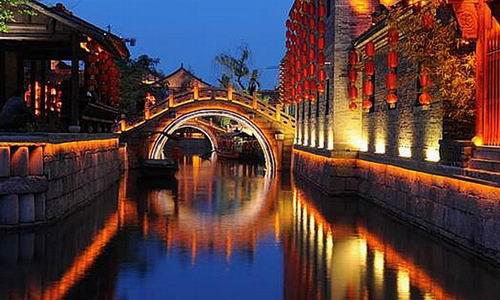
In June 2014, the 2,500-year-old Beijing-Hangzhou Grand Canal, running a length of 1,797 kilometers, made the World Cultural Heritage list. The 42.5-kilometer-long stretch at Tai’erzhuang (now a district of Zaozhuang City, Shandong Province), at the junction of the upper and middle sections, is widely known as the sole east-west waterway of the Grand Canal. Qing Emperor Qianlong (1711-1799) once praised Tai’erzhuang as “the world’s most affluent town” because of its location at the border of Shandong Province and Jiangsu Province, a hub of roads and waterways where north meets south. For centuries thereafter it developed into a flourishing business town.
Economic Boom
Strolling around Tai’erzhuang, you can be fooled into thinking you are in a southern Chinese riverside town; myriad ponds are interlinked and eventually flow into the age-old canal forming the water system. These water passages are the veins of the town. With rowing boats as the main mode of transport, Tai’erzhuang is well deserving of the moniker, “Venice of the Orient.”
In ancient times, Tai’erzhuang was frequently paralyzed by the flooding of the Yellow River owing to its geography, so its inhabitants would build their homes on terraces. To manage the threat of high waters, local authorities installed locks along the canal. During the Ming (1368-1644) and Qing (1644-1911) dynasties, eight locks were set up along the Tai’erzhuang stretch of the canal. Passing through all these locks took several months in the flood season. Hence, merchants on their way through had no choice but to stop over in Tai’erzhuang, which, consequently, helped the town grow into a prominent business center along the canal.
During the reign of Qing Emperor Kangxi (1661-1722), there were 60,000 inhabitants and over 160,000 migrants in Tai’erzhuang ancient town. But it was during the ruling periods of Qing emperors Qianlong and Jiaqing (1736-1820) that the town witnessed its heyday. It was regarded as a hub of road and water transport as well as a center from which commercial cargo was distributed to surrounding provinces. Every year 112,000 tons of grain were transported through the waterways here and 7,700-plus barges passed through the locks, creating a vista of “merchant boats forming long queues along the river, lighting it up at night with their myriads of lamps and enlivening the air with sailors’ songs,” as recorded in the county annals.
Walking along the flagstone roads, a large number of old docks and mooring ports come into sight, which are well preserved as cultural relics. Architecture of various styles can be found throughout the town today, including the white walls and black tiles style of Anhui, the courtyards of northern China, typical Suzhou gardens and even a Western-style Gothic cathedral.
Through the extensive exchanges of people, commodities and information in history, the town developed into a melting pot of Eastern and Western cultures as well as North and South China civilizations. The town’s different architectural styles exist in perfect harmony: The dwellings typical of Shandong, Anhui and Fujian provinces stand back to back with buildings of distinct European features; and local religious architecture spans all major world faiths, including Judaism, Christianity, Islam, Buddhism, Taoism and Confucianism. The first joint stock enterprise in Chinese history, Chung Hsing Coal Mining Co., contributed to the establishment of Tai’erzhuang’s rail network, thus attracting foreigners, who introduced Western civilization into this historical and cultural town.
